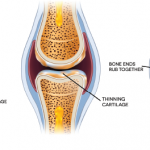Introduction & Objectives
Populations around the world are rapidly aging, and good musculoskeletal health is needed for people to have economic, social, and functional independence throughout their life course. But the importance of musculoskeletal disorders is often underappreciated.
The burden from musculoskeletal disorders is greatest among aging populations, with resultant enormous costs to the economy and the healthcare system.
Safiri et al. set out to provide a global overview of this burden, reporting the levels and trends of prevalence, deaths and disability-adjusted life years (DALYs) due to musculoskeletal disorders—categorized as low back pain, neck pain, osteoarthritis (OA), rheumatoid arthritis (RA), gout and other musculoskeletal disorders—according to age, sex and sociodemographic factors.
Methods
Data were obtained from the Global Burden of Disease (GBD) Study 2017. The fatal and nonfatal burdens of musculoskeletal disorders were estimated using the Cause of Death Ensemble model and Bayesian metaregression tool, respectively. Estimates were provided for all musculoskeletal disorders and the corresponding six categories at global, regional and national levels from 1990 to 2017. Counts and age-standardized rates per 100,000 population along with 95% uncertainty intervals (95% UIs) were reported for prevalence, deaths and DALYs.
Results
In 2017, approximately 1.3 billion people around the world had a musculoskeletal disorder, and 121.3 thousand deaths and 138.7 million DALYs could be attributed to musculoskeletal disorders.
Age-standardized prevalence, death and DALY rates per 100,000 population were 16,276.2 (95% UI 15,495.5, 17,145.8), 1.6 (95% UI 1.4, 1.6) and 1,720 (95% UI 1,264.4, 2,259.2), respectively. Age-standardized prevalence (−1.6% [95% UI −2.4, −0.8]) and DALY rates (−3.5% [95% UI −4.7, −2.3]) decreased slightly from 1990. The global point prevalence rate of musculoskeletal disorders in 2017 was higher in women than in men and increased with age up to the oldest age group.
Globally, the proportion of prevalent cases according to category of musculoskeletal disorders in 2017 was greatest for low back pain (36.8%), followed by other musculoskeletal disorders (21.5%), OA (19.3%), neck pain (18.4%), gout (2.6%) and RA (1.3%). These proportions did not change appreciably compared with 1990.
The burden due to musculoskeletal conditions was higher in developed countries. The countries with the highest age-standardized prevalence rates of musculoskeletal disorders in 2017 were Switzerland (23,346.0 [95% UI 22,392.6, 24,329.8]), Chile (23,007.9 [95% UI 21,746.5, 24,165.8]) and Denmark (22,166.1 [95% UI 20,817.2, 23,542.1]). The greatest increases from 1990 were found in Chile (10.8% [95% UI 6.6, 15.4]), Benin (8.8% [95% UI 6.7, 11.1]) and El Salvador (8.5% [95% UI 5.5, 11.9]).
Conclusion
Musculoskeletal disorders pose a large burden globally, with some notable inter-country variation. Some countries have twice the burden of other countries. Increasing population awareness regarding risk factors, consequences and evidence-informed treatment strategies for musculoskeletal disorders, with a focus on the older female population in developed countries, is needed. This is particularly true for low back and neck pain, and OA, which contribute a large burden among this cohort.
Refer to the full study for all source material.
Excerpted and adapted from: Safiri S, Kolahi A-A, Cross M, et al. Prevalence, deaths, and disability-adjusted life years due to musculoskeletal disorders for 195 countries and territories 1990–2017. Arthritis Rheumatol. 2021 Apr;73(4):702–714.


